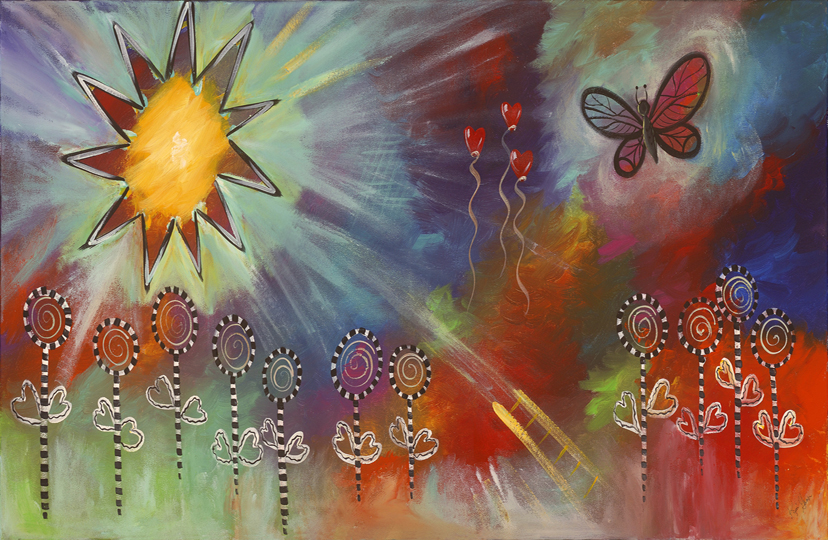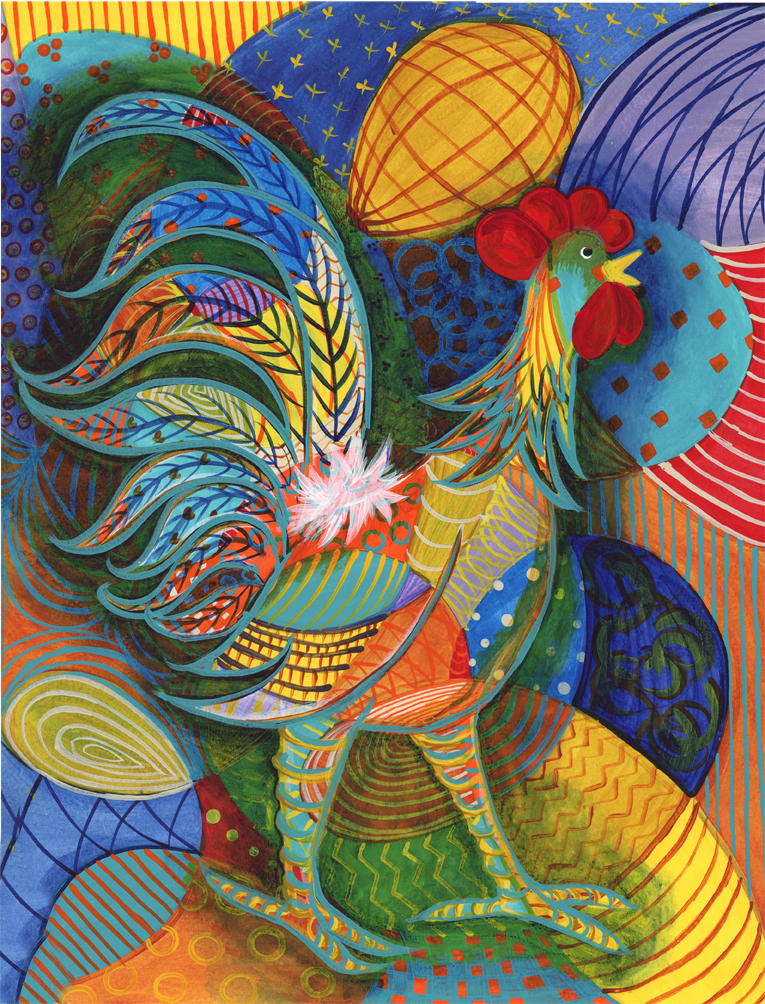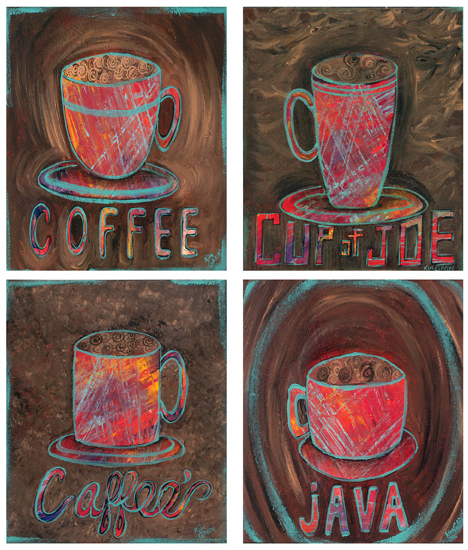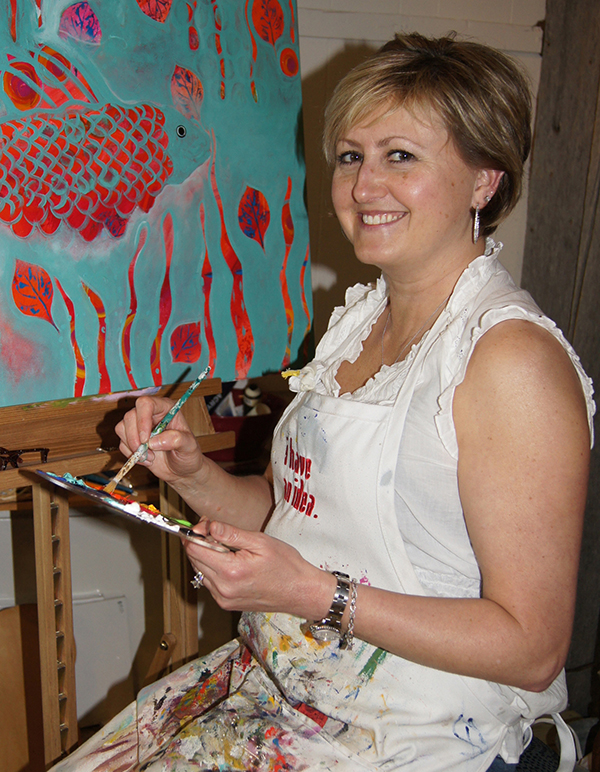For the month of November we are delighted to welcome Kim Gann as our guest expert in the Textile Design Lab. Kim is a licensed artist with wall art, needlepoint, flags and fabric under her belt, including two collections with P&B Textiles. Later this month in the Lab Kim will be sharing a tutorial on creating art for digitally printed quilt fabric (stay tuned for an excerpt!) For now we invite you to get to know Kim in the interview below.
Tell us a bit about your design background/career path. What led you to the world of art licensing?
I am a self taught artist with no design background other than what comes from within. I know my path is directed from God who created me as an artist. I once said this to a group and was told I shouldn’t say that because some people would think I was crazy, but it is my belief. I have been painting and drawing my entire life. My favorite gift as a child was a fresh box of crayons. My path traveled into crafts in my 20’s. My business was called Eggs Etc. I painted wooden egg Christmas ornaments as well as driftwood, gourds, okra, sand dollars, rocks, anything that didn’t move. In my 30’s I opened my first art studio/ shop in October 2001, just after 9/11. Everyone told me I was crazy then too, but I knew it would be ok. During this time I painted mainly landscapes and still life’s, but never painted just for me. In my 40’s I had a change of life, went into the family business recycling scrap metal from vehicles, but needed to paint. So on Labor Day weekend 2009 I nailed 2 nails into my kitchen wall, hung a 24×36 canvas and began painting this chicken I envisioned. This was the beginning of The Chicken Coop Series and this painting was Cuppa Joe. That weekend I also met my husband to be who gave me the support and encouragement to paint my ideas. With his continued support and ideas that my art should be on everything I started researching how to get my art on product. We would go into stores and he would say “your art should be on that” so we would look at the bottom of the product, make notes of the manufacturer and/or artist and I would research. In January 2012 I discovered Surex and in May 2012 I exhibited there. I didn’t get any contracts, but did get lots of contacts and ended up on the front page of their website for 2013, which was amazing! In 2013 I was discovered by P&B Textiles and had my first fabric collection Flying Sweetly for 2014. My second collection was Fancy Feathers. Both were in the Digital Line.

I love seeing my work on product and feel it is a better way to get it out in the world rather than just as prints and notecards. It’s great to be able to paint something once, but have it printed on so many different products. When I painted eggs I had to paint each one, the same thing over and over. When someone mentioned putting them in magazines and getting them out into the world I said no, I never heard of licensing. I thought I would be painting each one of them and I was already painting Christmas ornaments in July. I don’t really find it challenging to work this way unless I have several deadlines due at the same time. I paint better alone, so me time at the studio is great. I do like to make things with a group. I have chosen to license because I want to keep some control of my art. I also want to be able to freshen up older pieces and use them through out my career, if possible. I feel if I sell the copyright, I would have to wipe it away from my portfolio.

Red Carpet Licensing is great! It’s the place to be to have a one on one portfolio show directly with the art directors. I have direct access to companies I am interested in working with and can share my portfolio or new work with them and it goes directly to their inbox. With Red Carpet Licensing I am still representing myself, but there I don’t have to submit to a general submissions email. I can simply share my info with the companies I am interested in and they can see my profile and portfolio.
Could you talk a bit about the different licensing trade shows you have attended? Do you have any tips or suggestions for designers interested in exhibiting?
I have attended and exhibited at Surtex. It’s a great show to meet people, but very costly. When I exhibited exhibitors received free entry into the National Stationery Show and the International Contemporary Furniture Fair. The National Stationery Show is a great place to talk to individuals who are selling their own goods, there’s more than just stationery. I didn’t attend last year, but have heard there have been changes. I would suggest designers do a lot of research about the show they’re interested in exhibiting at and actually walking the show first. If you decide to exhibit display only your best and freshest work. Don’t try to show everything on your walls, that’s what portfolios are for. You could have your portfolios organized by styles, year of creation, etc. This way you can show more or all of your work and you need to have lots.
Tell us about some of the different products/markets for which you currently license your patterns. What are your favorite products/markets to design for and what makes them so enjoyable?
I currently have art on needlepoint with Artneedlepoint.com, flags with Toland Home Garden, wall art with Laila’s and fabric with P&B Textiles. Fabric is the most enjoyable to me because I love to quilt, sew and make things. Being able to create with my own fabric designs is like a dream come true. I have such a deep connection with fabric coming from a family of quilters. It really excites my soul to be able to sew with my art. If I had to choose only one thing to license, it would be fabric. Something new is in the works!

I love color, so everything I create ends up being really colorful. I have a hard time with neutrals, they don’t make me happy. To me it’s natural for art to be bright, vibrant, happy and whimsical. I believe if designers will create art that makes them happy and won’t get wrapped up in what anyone else is doing, their art will convey the strong message of who they are as designers.
What role do trends play in your design process? Do you find that trends hold as much sway in the licensing world or is the personal style of the designer a bigger factor?
I don’t really keep up with trends, but I am aware of them. Sometimes I find myself incorporating a trending icon into my art, but I never follow the color trends…they don’t make me happy. I believe personal style is a bigger factor in licensing, remember… you want to be different, you want to be you!
What have been some of the challenges you have faced throughout your design career and how have you overcome them?
My challenge is the business side of being a licensed artist. There’s a lot of work, it isn’t just painting, sewing and creating all the time. Submissions are very important and keeping track of it all. You have to keep yourself out there. Social media marketing takes a lot of time as well. I have a day planner I keep dates in and I create folders on the computer for the different companies I work with and want to work with. In those folders I add the artwork I send. I create email folders for all correspondence with companies I work with or submit to. I haven’t overcome my challenges yet. Maybe I’ll get an agent.
Visit Kim online at http://www.kgartstudio.com/, on Facebook and on Instagram. Interested licensees can sign up for a free account with Red Carpet Licensing to view Kim’s full portfolio at http://artlicensingshow.com/members/kgartstudio/profile/.
Become a Textile Design Lab member to gain access to Kim’s tutorial on creating art for digitally printed quilt fabric when it becomes available later this month, in addition to all of our past guest expert tutorials and the other helpful e-courses and features of the Lab. Visit textiledesignlab.com to learn more!













